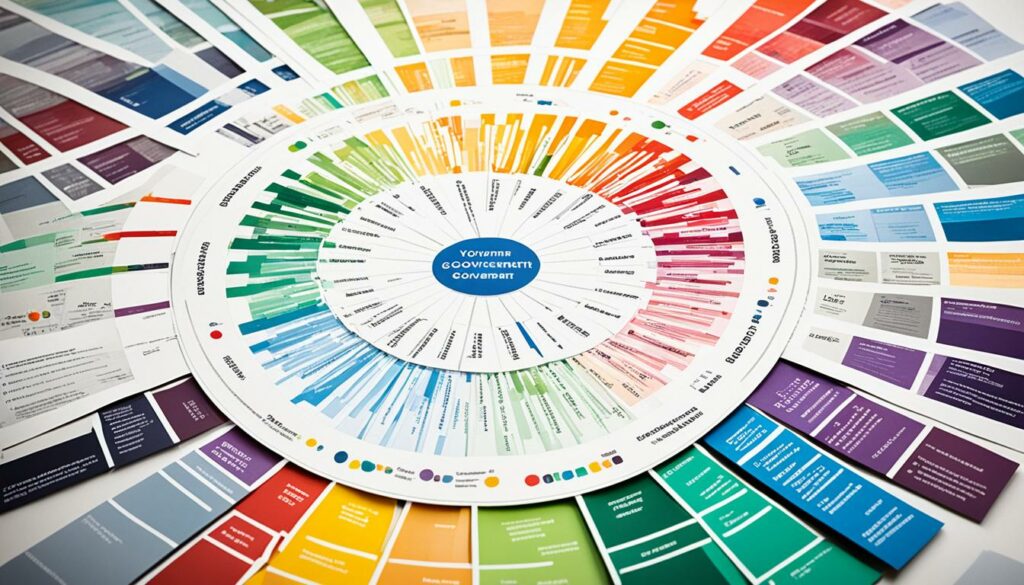Menu

Government policy isn’t just about what the government decides. A wide range of people is involved, including experts in policy, those who give advice, and those who analyse data. These efforts aim to fix problems in society, help the economy, and lay down ways to keep things going steadily.
Data plays a huge role. Making decisions backed by facts helps use money better. This is key in developing policies that work well and last a long time. Public policy includes different types, such as those that focus on what’s right and wrong, how things are shared out, and changing these shares if needed to tackle issues.
Education policies, for example, aim to make students do better by updating what they learn and training teachers. Policies in the justice system aim for fair punishment and to lower crime rates. And migration policies aim to protect borders and improve how visas work, managing the movements of people.
Then there are policies for technology and pushing new ideas, which want to increase money for research and help new businesses start up. Environmental policies are key too, setting rules for what’s put in the air and encouraging practices that keep our planet safe. By working on these different policies, we can help the economy and make sure our plans really last.
Public policy is about the actions governments take to solve big issues. It includes laws and plans to make life better for everyone in a country. The process of making these policies involves many parts of the government working together. This teamwork helps manage the country wisely.
The public policy process is careful and covers many problems in society. There are four main types of policies. Each type focuses on different social needs. These policies are made using a lot of data. This helps those in charge make smart decisions about how to spend money.
One example is education reform. This looks to make students do better at school. It also aims to make sure all students get the same chance for a good education. On the other hand, policies in the justice system try to be fair. They also work to keep the public safe by changing how people are punished and helping them come back into the community.
There are several important bits to making public policies. One key part is working together. This includes government workers, experts, and others. They share their knowledge to make good laws and plans. They look at the past and take into account cultural differences. This helps make policies that truly help people.
Setting a policy agenda is also vital. It helps focus the government on what’s most important. Policies could be about the environment, jobs, or health. It’s all about finding good solutions using facts and advice from experts.
Many groups are involved in making public policies. This includes government leaders and everyday people. Each brings something different to the table. Working together, they make sure the policies meet society’s needs.
Often, the government teams up with non-profits and local groups to make new policies work. For example, technology policies might include help from research groups. Together, they can make changes that benefit the whole community.
| Policy Type | Purpose | Example |
|---|---|---|
| Substantive | Address core societal issues | Education reforms, healthcare regulations |
| Regulatory | Ensure safety and ethics | Environmental standards, financial regulations |
| Distribution | Allocate resources equitably | Housing policies, social security programs |
| Redistribution | Reallocate resources to balance inequalities | Progressive taxation, welfare benefits |
Data is vital in creating effective policies. It helps policymakers make decisions based on facts, ensuring resources are well used. By using data, policies can solve real problems in society effectively.

Decisions based on data allow for proactive rather than reactive approaches. This makes policies work better and saves money by using resources wisely. With analytics and visualisation, policies can be both effective and efficient.
A well-balanced mix of numerical and descriptive data is key in policy making. Numbers enable quick and accurate decisions while stories show the real-life impact. For example, during Hurricane Harvey, Texas saved a lot by using advanced data. This shows how important both types of data are.
To make data work in policies, a solid plan is essential. This plan must include methods for gathering, using, and tracking data. It’s important to have clear ways to manage the data and enforce the policy.
Success stories include innovative strategies in France, Belgium, and New Jersey. They show how strategic use of data can directly help people. Such efforts highlight the importance of good data and its careful use.
| State | Initiative Description | Outcome |
|---|---|---|
| Texas | Utilised sophisticated data capabilities during Hurricane Harvey | Saved millions of dollars |
| New Jersey | Analysed data on prescription drug program | Targeted senior citizens for assistance programs |
| Virginia | Shared data between human services agencies and nonprofits | Reduced veteran homelessness |
| Colorado | Detected fraud in opioid prescriptions through data analysis | Improved healthcare supervision |
Mixing both kinds of data enriches policy planning. It’s not just a method; it ensures well-rounded and powerful policies. This has been proven by many states, showing us the great value of using both kinds of data.
To tackle big societal problems, we need strong policies. These policies touch many sectors and change how our community works. They’re not just words; they make things better for everyone.
In the United States, education reform is key for helping all students do better. It includes changing what we teach, improving how we train teachers, and making sure everyone can access good education. The goal is to give everyone a fair chance to learn and succeed, both now and in the future.
Making our criminal justice system fairer is very important. This means working on strategies to lower crime, changing how we sentence people, and helping prisoners rebuild their lives. By doing this, the justice system tries to be more about justice for all. It works to end unfair treatment and to ensure that punishments fit the crimes.
Immigration policies focus on important things like keeping the border safe and updating who can come and live here. These rules aim to control immigration while still respecting everyone’s rights. Good immigration policies help keep the country safe. They also make sure everyone feels welcome, offering clear ways for new people to join in.
Regulatory policies aim to balance public welfare and industry. They use standards to protect our environment and health. Policymakers study data and history to create rules that fit with our society and politics. These rules protect us and help the planet.

Environmental policy is key for green initiatives. It puts limits on harmful stuff and manages resources. These rules push companies to stay clean while saving our planet for those who come next.
Keeping us safe to eat is a big part of the job for regulators. They watch over food from start to finish. Their strict rules cut down on food sickness, making sure what we eat is safe and good for us.
Work rules defend worker rights, like fair pay and safe jobs. They keep work running well and happy. With these rules, working life is fairer and safer for all.
Finance rules keep money systems steady and honest. They guard us from scams and keep money markets trusted. These rules watch over banks, investments, and money services to keep our money safe and sound.
Medical rules check the quality and safety of health services. They look at medicine making, health insurance, and doctor rules. These healthcare rules make sure we get safe and great care when we’re sick, protecting everyone’s health.
| Domain | Focus | Impact |
|---|---|---|
| Environmental Policy | Pollution control, resource management | Promotes environmental sustainability and conservation |
| Food Safety Regulations | Food quality, safety standards | Protects public health by preventing foodborne illnesses |
| Labour Regulations | Worker rights, fair wages | Ensures a fair and safe working environment |
| Financial Regulations | Banking oversight, consumer protection | Maintains financial stability and trust |
| Healthcare Regulations | Medical standards, drug approvals | Ensures high-quality healthcare and patient safety |
Making sure resources are shared fairly is key for social fairness and economic strength. Policies are set to give everyone better chances and resources. They help make society more equal, giving everyone a fair shot at success.
Having a home you can afford is vital for fairness. Many rules are in place to make sure people can find secure, low-cost homes.
An example is the help given through housing subsidies, zoning changes, and laws against discrimination. Groups like the Housing and Urban Development Department work to make sure these resources are available.
Since 1967, the National Academy of Public Administration and similar groups have helped the government improve these policies.
Programs for social security really help keep the economy strong and look after people. They provide help if you’re unemployed, disabled, or need pension support. A law from 2010 makes sure federal plans are clear and helpful.
Evidence shows these actions are working:
| Policy Initiative | Impact |
|---|---|
| Equity Action Plans (2022) | 90 agencies released plans to advance racial equity. |
| American Rescue Plan | Historic advancements in economic stability and social welfare. |
| SNAP Benefits | Increased by over $36 per person per month. |
| Summer Meal Programs | Provided meals to over 30 million children. |
These actions show a real dedication to social welfare and fairness, creating a more even society. Social fairness is a top goal in our distribution plans. We work to lessen the gaps and ensure fairness for all.
Public sector strategies are crucial for successful policy initiatives in governments. They help tackle major issues like the COVID-19 crisis, economic problems, climate change, and running out of resources. Countries such as Singapore, South Korea, Japan, and those in Scandinavia are changing how they view public administration. They see it as key to reaching societal goals.

For example, Strategy& helped the U.K. cut 3 million tons of CO2 emissions. This shows how powerful coordinated strategies can be. In the Middle East, 400 stakeholders came together for a reform plan. It shows the importance of working together across different agencies to get things done.
In Europe, a strategy for making data compatible made importing and exporting goods easier. This highlights the importance of using strategy to manage resources well. Today’s governments focus on leading effectively from the top, involving citizens, creating public value, being open, and working closely with others.
Investing more in strategic skills in public administration has boosted success, according to research. But, there’s a drop in people’s trust in public institutions, from 65% to 52%. This data from the Edelman Trust Barometer shows governments need to do better in their strategies.
The United Nations Development Programme and the OECD are using a new model to guide governments worldwide. This model aims to add public value and make governance better.
In conclusion, using public sector strategies has a big potential for good. The table below gives more details on the outcomes of these strategies:
| Region | Key Strategic Initiative | Impact |
|---|---|---|
| UK | CO2 Reduction | 3 Million Tons Reduced |
| Middle East | Socio-Economic Reform | Engaged 400 Stakeholders |
| Europe | Data Harmonisation | Streamlined Import/Export Clearance |
| Global | Strategic State Paradigm | Improved Public Value Delivery |
Legislative guidelines act as the foundation for policy implementation. They describe how governance should work. Good guidelines make sure everything runs smoothly and compliance is clear.
The Programme for legal questions has been updated several times (2013, 2016, 2019, and 2023). This shows we keep our laws fresh. Directive 69: Legal Guidance adaptation (July 29, 2019) shows we are serious about enforcing policies.
Regular checks and audits are key for policy success. The Procedures for checking compliance and legal advice (2010) are crucial. Also, making documents public in certain cases (2016) shows our commitment to transparency.
Studying how laws change over time is interesting:
| Policy/Document | Year of Revision/Implementation |
|---|---|
| Programme for Requesting Consideration of Legal Questions by the Commission | 2013, 2016, 2019, 2023 |
| Directive 69: Legal Guidance to the Office of Compliance | 2019 |
| Disclosure of Certain Documents in Enforcement Cases | 2016 |
| Procedures for the Audit Process and for Legal Guidance | 2010 |
Furthermore, adding new procedures is important. The Proposal for better Audits and Legal Advice (Agenda Document 10-30) is one example. Placing legal reports in the public eye (2009) also helps keep us honest.
Improving and making guidelines clear is crucial. It helps us implement policies better. It also ensures our government is honest and just. We all benefit from well-regulated laws.
State programmes play a key role in boosting community development. They focus on making society better by improving homes, building things, and offering public help. Take the Housing Accountability Unit (HAU), for example. It was set up in the 2021-2022 state budget to help solve California’s housing problem. It keeps the Housing Accountability Dashboard up to date. This helps make sure that the housing rules are followed closely.
There are laws that show how important these state programmes are. A set of laws, from section 65580 to 65589.11 of the Government Code, gives the Housing and Community Development (HCD) group power. This power lets them check if local decisions go against the law about building homes. Also, the Housing Accountability Act stops local areas from blocking housing projects that meet their local rules. This helps keep the chances fair for community development.

The ‘No Net Loss Law’, in section 65863 of the Government Code, is about keeping enough land for building houses. The Density Bonus Law, found in sections 65915-65918, helps make building affordable homes more appealing to builders. It does this by offering them extra homes to build and benefits. Both laws really help in making the society better for everyone.
Programmes from the state also look out for those who are unfairly treated. For instance, the Violence Against Women Act (VAWA) makes sure places to live are safe for women and children who suffered from violence. The U.S. Department of Housing and Urban Development (HUD) makes sure these survivors get housing help. This is all about making sure society takes care of those in need.
Also, the Government sells some buildings for very low prices to help people build or fix their homes. This really helps those with low incomes. The HUD Demonstration Act of 1993 supports local groups working on building cheap homes. With this help, the groups get money from private donors three times the amount given by the Act.
After disasters, the Community Development Block Grant Disaster Recovery (CDBG-DR) programme provides money to fix things and restart economies. This is key for areas hit by disasters to bounce back. The use of this money is carefully watched to ensure it helps in the best way possible.
The SUPPORT Act introduces new ways to link healthcare and housing for those fighting drug addiction. It’s part of a bigger effort to help people find stable homes. By addressing homelessness, these efforts also work towards making communities safer and better for everyone.
Official regulatory plans are key in putting policies into action in different areas. They make sure there are clear rules to follow. This keeps everything safe, ethical, and in line with rules. Accountability and sticking to the rules under serious government oversight are also part of the plan.
Carrying out these plans means keeping an eye on them all the time. People check regularly to make sure they are working well. This helps keep everything fair and on track. Here’s how we know these plans work:
| Key Aspects | Statistics |
|---|---|
| Increase in citizens’ access to government data and information | 14% |
| Commitments in the Fifth U.S. Open Government National Action Plan | Over 30 |
| Decline in global democracies | More than half in the last decade |
| Public responses collected for National Action Plan | Over 700 |
| Virtual open engagement sessions held | Six |
Regulatory frameworks grow by making promises in key areas. This includes making it easier to see government info and making services better. This lines up with Executive Order 13985, aiming to help those who need it most. It also pushes for fairness under the law for everyone.
Making sure people follow the rules takes a smart and quick plan. By listening to over 700 thoughts from the public, the government shows it cares. Having six online talks is another sign of working together.
These plans play a big part in fighting corruption and making sure things are fair. Setting out what success looks like and keeping an eye on costs help these plans work better. Choosing the right deals and ways to pick who does the work keeps everything fair and open.
Getting things right and watching how things are done closely needs careful thinking and action. Figuring out where to get help, what needs to be done, and managing risks are big parts of this. All of this makes official plans strong and honest.
Government policy initiatives cover a wide range of programmes and actions. They work towards meeting specific societal goals and challenges. These include plans for the economy, health system changes, and steps to protect the environment. All are aimed at achieving certain results and addressing both immediate and long-term needs.

The Federal Communications Commission (FCC) has pledged $2 billion over two years to improve Internet access for schools and libraries. This initiative aims to connect 20 million additional students to high-speed Internet. Besides, private companies have promised more than $2 billion to bring the latest technologies to schoolrooms. This shows how policies can make a big difference in education.
The USDA and SBA have given out $175 million in microloans for small businesses in rural areas for FY 2013 and 2014. They’ve also supported rural small businesses with over $85 million.
These initiatives help a lot in building up communities and ensuring economies grow. For example, the USDA has committed over $33 million this year to help farmers and others through its National Water Quality Initiative. Back in FY 2011, the Administration put in more than $400 million in rural America through the SBIC Impact Investment Program.
| Initiative | Target | Investment | Outcome |
|---|---|---|---|
| High-Speed Internet Connectivity | Schools and Libraries | $2 Billion | Connecting 20 million students |
| Microloans for Small Businesses | Rural Areas | $175 Million | Business growth and sustainability |
| Financial Assistance for Farmers | Farmers, Ranchers, Forest Landowners | $33 Million | Enhanced water quality and environmental sustainability |
The initiatives show how smart investments in different areas bring new ideas and help economies grow. For instance, the MOU that joins the USDA-RD, HUD, and CDFI, offering up to $200,000 to nonprofits in the U.S./Mexico border, is a great example. It shows the real impact of government efforts on local needs.
To sum up, government efforts lead to big improvements in society. By making strategic investments and important changes, these actions bring long-term benefits. They help the country move forward as a whole.
Administrative directives are key in making how things run better. They affect how well rules are followed and the work we do. The Open Government Directive, made on December 8, 2009, is an important example. It aimed to make things clearer and more honest.
Agencies had to pick and share at least three top data sets online in 45 days. This made information available fast. They also had to make a web page about open government in 60 days. This helped people find the info they needed and join in more.
The directive also changed how FOIA requests worked. Agencies had to cut down on big waiting lists. They should make the FOIA process faster and better for people.
They also had to follow President’s orders about places like Data.gov and Recovery.gov. They had to name someone senior who would make sure government spending info was good. This showed the strict rules in these directives.
A plan for open government had to be ready in four months. A dashboard to keep an eye on things was set up in two months. These steps kept things clear and honest.
Admin directives are also key for keeping important places safe. This includes working with owners and global partners. The goal is a safe network for everyone, home and away.
Thanks to these rules, energy and tech systems are stronger. The plan boosts these areas, making them more reliable. It makes sure services keep going even when things get tough.
The true measure of success is how well the government keeps its critical parts safe. It involves finding risks and protecting what’s most important. This is done to keep services running smoothly. Laws and directives show the whole process cares about fairness and safety for all.
This all works because everyone pulls together. The Homeland Security Secretary leads this. They check our ability to handle problems. A team effort makes our systems safer, showing the value of these rules.
SSAs are a key part. They manage tasks in their areas and help out where needed. By looking into weak spots, they help keep everything strong. Their work makes sure our country and its people stay safe and sound. It all adds up to better government, proving the worth of smart, clear directives.
Authority policies are essential for regulating different industries. They offer solid guidance. This helps manage day-to-day actions within a business field.
For instance, the U.S. Department of Education is working to improve Internet access for 20 million students in rural places. This effort aims to bridge the digital gap. It also promotes better learning with new broadband technology.
The U.S. Department of Agriculture is investing over $33 million to better water quality in specific areas. This shows how rules specific to an industry can help the environment and local people. It focuses on keeping farming sustainable.

The White House Rural Council is putting $175 million into small loans. This is to help grow rural economies. They want to support small businesses, creating more jobs. It shows how rules can help different parts of the country in unique ways.
The Obama Administration has pushed for more bio-based items to be bought by government agencies. This helps create jobs in rural areas. The Rural Jobs Accelerator also helps with finding jobs in rural places. It uses around $9 million to boost employment.
Investment in health is also happening. There’s a plan to increase the number of Health Information Technology workers by 20%. This is important, especially in the countryside. It will help many rural hospitals and clinics serve their communities better.
| Sector | Initiative | Investment |
|---|---|---|
| Education | High-speed Internet for rural schools | $2 billion |
| Agriculture | Water quality conservation | $33 million |
| Economic Development | Microloans for rural businesses | $175 million |
| Job Creation | Rural Jobs Accelerator | $9 million |
| Healthcare | Training HIT professionals | 20% workforce increase |
It’s crucial that policies change with the times. They must always be based on sound evidence. This helps them support sectors well and look out for the public.
Government policies are vital for how our society works and grows. These policies shape our lives and help create a better future. We need to carefully check these policies to make sure they’re working well.
Looking ahead, we must be ready to change our policies. The world keeps changing, so our policies must change too. Changing policies help us meet the new needs of people and the world. This is how we keep moving forward.
To improve society, we must make policies with care. These rules and plans need to be clear and easy to understand. They should be based on solid facts, not big words. I suggest learning more about this from special resources for making good policy briefs.
Government policy initiatives are programs set to meet goals and solve issues. They include measures for the economy, healthcare, and the environment. Each aims to achieve specific results.
Public policy deals with societal problems. It can be about issues within a nation or improving people’s lives.
Major stakeholders in public policy are governments, policymakers, and groups that work with them. They also involve the general public.
Data plays a critical role in making policies. It helps in making decisions based on facts. This ensures resources are used wisely.
Quantitative data is about numbers, showing clear evidence. On the other hand, qualitative data helps understand the context. Together, they lead to strong policies.
Educational reforms want fair, top-quality learning. They focus on improving what’s taught, training teachers, and making education more available.
Regulatory policies keep industries honest and safe. They put rules in place to protect the environment, food safety, and our health.
Social security helps with money for times like unemployment, disability, and when we retire. It aims to keep people financially stable and respected.
The public sector works with others, manages resources, and sticks to plans. This ensures they meet our needs well and improve services.
Legislative guidelines set rules for putting policies in place. They make sure everything is legal. They also show what government and courts must do.
State-led projects boost communities in different ways. They cover things like community renewal, education, and health. Their aim is to make life better.
To carry out plans, officials check that rules are followed and see if they work. This keeps the public safe and happy.
Directive examples are in health, education, and the economy. They bigly affect people’s welfare and how the government runs things.
Each sector gets its own set of rules. These help overcome unique problems, encourage new ideas, and safeguard the public’s interests.